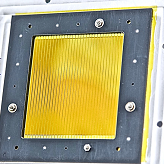A new monitor for protontherapy


How to monitor continuously but without disturbing them charged particle beams like those used in proton therapy? By interposing as little material as possible! These are 1.5 micrometers (0.00015cm) membranes on which strips of 50 nanometers are deposited which form the new ultra-thin monitor developed by the "Medical Applications" group of the Leprince Ringuet Laboratory (LLR, a joint research unit CNRS - École Polytechnique). The patent for this PEPITES monitor has just been published.
Ultra-thin, in particular thanks to the thinness of its membranes made of a material developed for solar sails, PEPITES can permanently measure the parameters of the beam while offering minimal disturbance, without saturation and remaining very tolerant to radiation. Its measurement signal comes from a very linear and surface phenomenon: the emission of secondary electrons by a thin layer of gold on the passage of the beam. This process thus allows the construction of an extremely thin sensitive area.
This ultra-thinness allows operation at high intensities because it reduces overheating due to interactions with the beam. Used in a vacuum (integrated into the beamline), its membranes thus support radiation alterations much better. The system is simple to use and finds applications far beyond the medical field initially envisaged.
An adventure within the Research Center
Contacted in 2014 by the European leader on the proton therapy market to think about new monitors for its new treatment machines, the LLR team quickly opted for the study of a detector based on the secondary electron emission phenomenon.
Thanks to the help of the Laboratory of Physics of Interfaces and Thin Films (LPICM, a joint research unit CNRS - École Polytechnique), they built a first prototype that they were able to test with 70 MeV proton beams at the Arronax cyclotron (St Herblain).
In parallel, they studied radiation resistance at the Laboratory of Irradiated Solids (LSI, a joint research unit CNRS - CEA - École Polytechnique joint research unit), then at the Center for Nuclear and Material Sciences.
Funding from the ANR and the Labex P2IO then made it possible to continue the adventure, while a patent filing was quickly initiated with the help of the Partnership Research and Intellectual Property Service of École Polytechnique.
The next steps
The construction of a working prototype is underway. It will be installed in 2021 on an Arronax beamline and then used routinely to benefit from feedback on the in-situ behavior of the monitor. This is an essential point for the eventual adoption of the technique in the medical field. PEPITES also received a more than favorable reception, whether in the world of medical research or particle physics, during its presentation at several international conferences.
Shortly, the technology should apply to very promising "Flash" therapies, where the tumor is treated in a short time but with a dose rate at least 100 times higher than that of current treatments.
Learn more :
 Support l'X
Support l'X